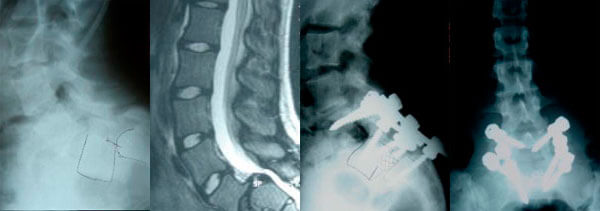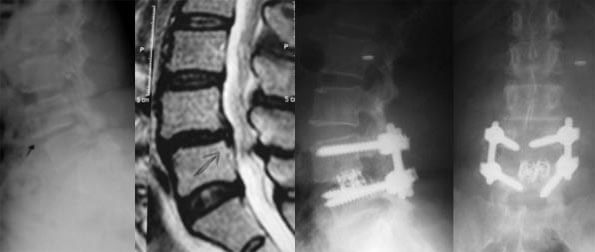Spondylolisthesis
Spondylolisthesis is a condition of the spine in which a vertebra has slipped forward on the vertebra below. There are six types of spondylolisthesis based on the cause of the slip. These include dysplastic or congenital type caused by an abnormality of the joints of the spine. Isthmic type is a result of a fracture through a portion of the vertebra called the pars interarticularis that allows for slippage to occur in some patients. The fracture is termed spondylolysis. A third and very common type in the adult patient is degenerative spondylolisthesis that most commonly occurs at the L4-5 level and is a result of degenerative disc disease and arthritis of the joints of the spine that is usually accompanied by spinal stenosis or narrowing of the spinal canal. This generally causes back pain and limitations in walking ability. The first two types of spondylolisthesis (dysplastic and isthmic) often present in childhood and are localized most often to the L5-S1 level or lowest joint of the spine. Another form of spondylolisthesis is traumatic, resulting from fracture of a portion of the vertebra other than the pars interarticularis. Pathologic type is a result of tumor or infection eroding the spine and again causing instability leading to slippage. A final category of spondylolisthesis is termed iatrogenic. This occurs in patients who have had extensive laminectomy or decompression of the spine resulting in instability. Each type of spondylolisthesis has its own specific presenting findings and treatment that is directed to the specific features of the disorder (see articles on isthmic and degenerative spondylolisthesis).
Patients with spondylolisthesis, are they children or adults may present with back and/or leg pain, urinary incontinence or frequency, or may have little or no symptoms at all. Treatment is based on the severity of the patient’s symptoms, as well as the degree and extent of slippage noted.
TREATMENT
Nonoperative:
For the child with spondylolisthesis associated with back pain, activity modification is recommended. Sports activities should be curtailed and relative rest is recommended. Often, patients with spondylolysis are engaged in activities associated with hyperextension such as gymnastics, football or wrestling. These activities should be stopped. If pain does not subside with activity modification, a brace is recommended and should be worn full-time for at least 3-6 months. Occasionally, a stress fracture will heal with bracing, but this is not always the case. Even without healing, most patients experience pain relief.
For the adult patient, pain is generally the major complaint, and may limit the ability of the individual to walk distances. Patients may be referred for physical therapy and are given a prescription for a nonsteroidal anti-inflammatory medication. In selective cases, epidural steroid injections or selective nerve root blocks help in controlling symptoms.
Operative treatment:
For the pediatric patient with spondylolisthesis that has failed to respond to nonsurgical modalities, a fusion operation is recommended. If the slippage is relatively minor, the fusion is performed in-situ (in place). This is typically done from a posterior (back) approach and is usually accompanied by spinal fixation using implants. For higher-grade slips, a reduction is generally recommended so as to bring the slipped vertebra into a more anatomical alignment. The reduction itself is associated with some neurological risk in that weakness of the big toe, or foot for example, may occur, although this is almost always temporary. A final option for patients with minimal slippage associated with a stress fracture (spondylolysis) is a repair of the stress fracture with bone grafting and spinal implants. The majority of patients experience pain relief and are able to return to most activities following these procedures.
In the adult patient presenting with degenerative spondylolisthesis in which spinal stenosis is present, a decompression or laminectomy procedure is done, and this is combined with a fusion using implants and bone graft. In some cases, the disc is removed and an interbody fusion is performed as outlined in the section on degenerative spondylolisthesis.
Spondylolisthesis is a relatively common problem and is most often effectively treated with nonsurgical modalities. When surgery is indicated, it is addressed to the specific nature of the disorder and in a majority of patient’s results in a good or excellent outcome.
Patient Story of Isthmic Spondylolisthesis

This adolescent girl had a high-grade spondylolisthesis of L5/S1. The pre-operative x-ray and MRI reveal the severity of the slip before surgery. The slip was corrected from a posterior approach with fusion and instrumentation. The patient is over 4 years out from surgery and is active and without back pain.
Patient Story of Degenerative Spondylolisthesis

This 58 year old woman had degenerative spondylolisthesis at the L4/5 level as shown on the x-ray and MRI above. She had difficulty walking distances and back and leg pain. She was treated with laminectomy and fusion with instrumentation (see article on PLIF, ALIF & TLIF for more detail).
More Spinal Information
Other Resources Recommended by Baron Lonner, M.D.
American Academy of Orthopedic Surgeons - Spondylosis and Spondylolisthesis
